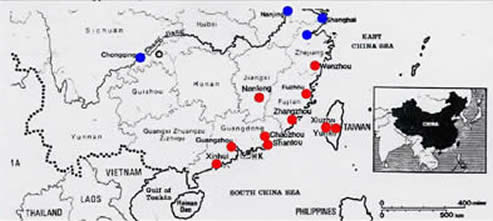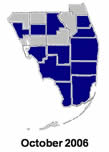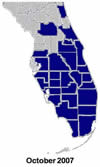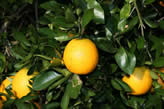Huanglongbing (HLB; citrus greening) is thought to be caused by the bacterium, Candidatus Liberibacter asiaticus. HLB has seriously affected citrus production in a number of countries in Asia, Africa, the Indian subcontinent and the Arabian Peninsula, and was discovered in July 2004 in Brazil. Wherever the disease has appeared, citrus production has been compromised with the loss of millions of trees. HLB has not been reported in Australia or in the Mediterranean Basin. In August 2005, the disease was found in the south Florida region of Homestead and Florida City. Since that time, HLB has been found in commercial and residential sites in all counties with commercial citrus.
The early symptoms of HLB on leaves are vein yellowing and an asymmetrical chlorosis referred to as “blotchy mottle.” The blotchy mottle symptom is the most diagnostic symptom of the disease, especially on sweet orange. Leaves may be small and upright with a variety of chlorotic patterns that often resemble mineral deficiencies such as those of zinc, iron, and manganese. Some leaves may be totally devoid of green or with only green islands. The blotchy mottle symptom also may be confused with other diseases or damage such as severe forms of citrus tristeza virus (CTV), Phytophthora root rot, water logging, citrus blight, leafminer tunnels or stubborn, a disease that is not known to be present in Florida. Root systems of infected trees are often poorly developed and new root growth may be suppressed. Early symptoms of yellowing may appear on a single shoot or branch. The yellowing usually spreads throughout the tree over a year, especially on young trees, and affected trees may show twig dieback, causing the productivity to decline within a few years. Fruit are often few in number, small, may be lopsided with a curved central core, and fail to color properly, remaining green at the stylar end. Many fruit drop prematurely from afflicted trees. A yellow stain may be present just beneath the peduncle (stem) on a cut fruit. The affected fruit often contain aborted seeds and have a salty bitter taste.
-
History
Greening or Huanglongbing (HLB) Worldwide
Information and photos were obtained from the Journal of Plant Pathology, 2006, Huanglongbing: A Destructive, Newly-Emerging, Century-Old Diesease of Citrus by J.M. Bové
1919: First reported in southern China
1921: First report of disease in the Philippines, but it was thought to be related to zinc deficiency.
1928: A disease under the names, yellow shoot or greening depending on region, was observed in South Africa
1937: The first description of HLB in South Africa was assumed to be mineral toxicity
1941-1955: Most extensive work on greening in southern China was conducted
Areas visited in Southern China and Taiwan by Lin Kung Hsiang in between 1941 and 1955. Red dots represent where HLB was found and blue dots represent areas where it was unclear whether HLB was present.
1956: Lin Kung Hsiang (researcher from China) concluded that greening is a graft transmissible infectious disease, not related to physiological disorders (e.g. nutrient deficiencies, water logging, etc.) or soil borne diseases (e.g. phytophthora, etc.)
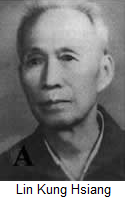
1960's: HLB first appeared in Thailand
1965: Researchers in South Africa demonstrated HLB was transmissible by graft inoculation and by the African citrus psyllid, Trioza erytreae
1966: Philippine and Indian researchers recognized the similarities between the 'mottle leaf' or 'citrus dieback' disease and HLB in China and Taiwan and 'greening' in South Africa
1967: Philippine researchers demonstrated 'mottle leaf' or 'citrus dieback' could be transmitted by the Asian citrus psyllid, Diaphorina citri
1995: The official name of the disease became huanglongbing (HLB) at the International Organization of Citrus Virologists (IOCV) at the 13th conference of the Organization in
Fuzhou (Fujiam, China)1998: Asian citrus psyllid arrived in Florida
2004: The disease was confirmed to be in Brazil
2005: The disease was confirmed to be in Florida
Florida History
2005
August -Citrus greening was first confirmed in south Miami-Dade county
October 25 - Four counties confirmed positive (Dade, Broward, Palm Beach, Hendry) Map
September 16 - Federal order issued to restrict the interstate movement of all citrus greening
and Asian citrus psyllid host plant material from Florida's quarantined areas2006
March 14 - Regulations for citrus nurseries were established
May 3 - The September federal order was revised
June 16 - Twelve counties confirmed positive (Monroe, Collier, Lee, Martin, St. Lucie, Highlands, DeSoto, Manatee) Map
2007
January 26 - Fourteen counties confirmed positive (Brevard, Hillsborough) Map
April 30 - Twenty counties confirmed positive (Orange, Sarasota, Volusia, Okeechobee, Glades, Charlotte) Map
May 31 - Twenty-two counties confirmed positive (Osceola, Seminole) Map
July 27 - Twenty-five counties confirmed positive (Hardee, Marion, Indian River)
August 24 - Twenty-six counties confirmed positive (Polk) Map
October 30 - Federal order revised
October 31 - Twenty-eight counties confirmed positive (St. Johns, Pasco) Map
November 2 - A third Federal order was issued due to the spread of greening and the Asian citrus psyllid
November 30 - Two new counties, Lake and Hernando, confirmed with citrus greening Map
December - Federal order issued was revised to include all counties with a confirmed positive greening find
2008

January 11 - Federal order issued to quarantine the entire state of Florida
June 24 - Thirty-one counties confirmed positive (Pinellas) Map
August 7 - Thirty-two counties confirmed positive (Sumter) Map
2009
February 16 - Thirty-three counties confirmed positive (Putnam) Map
-
Transmission and Spread
The Asian Citrus Psyllid transmits the greening bacterium. The psyllid was first found in Florida in June 1998.
Psyllid eggs are 0.3 mm long, elongated and almond-shaped. The newly laid eggs are pale in color, then become yellow and turn to an orange color as the time approaches for hatching
Nymphs are 0.25 to 1.7 mm and yellowish orange. Larger nymphs can be seen with the naked eye usually found on the young flush. The nymphs are sessile and move slowly if disrupted. They secrete sticky waxy secretions similar to honeydew produced by aphids which causes sooty mold.
The adults are 3 to 4 mm long. They have a brown mottled body and feed at a 30 degree angle. They can usually be found on the underside of leaves and move quickly.

Psyllid feeding damage (Deformation)
Click to enlarge
The disease can also be spread by grafting, but not all buds from an infected tree carry the greening bacterium
Citrus Huanglongbing: The Pathogen and Its Impact
Citrus Huanglongbing: Understanding the Vector-Pathogen Interaction for Disease Management
English Tap Sampling for Asian Citrus Psyllids (ACP)
Spainsh Tap Sampling for Asian Citrus Psyllids (ACP) -
Alternate Hosts
Alternate hosts plants of the Asian citrus psyllid are Murraya paniculata (orange jasmine), Severinia buxifolia (box orange) and other plants in the Rutaceae family.

Additional Information about Alternate Hosts
-
Nutrient Deficiencies Compared to Citrus Greening
Citrus greening symptoms can easily be mistaken for a nutrient deficiency. Nutrient deficiencies are often symmetrical on each side of the vein whereas, citrus greening is asymmetrical. Below are the symptoms of each the seventeen nutrients needed by citrus trees.
Nitrogen Deficiency
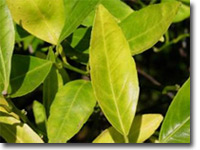
- Occurs on older leaves first then toward the younger leaves
- Light yellowish to green leaves. Mature leaves slowly bleach to a mottled irregular green and yellow pattern, become entirely yellow and then are shed
- Fruit peel is pale and smooth
Phosphorus Deficiency
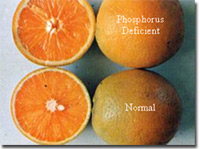
- Occurs on older leaves first
- Leaves are small and narrow with purplish or bronze discoloration
- Fruit drops before normal harvesting time, hollow core and thicker peel
Potassium Deficiency
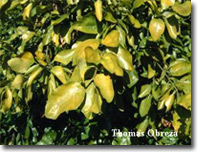
- Occurs on older leaves first
- Yellowing of the tips and margins and gets broader
- Smaller fruit size
Calcium Deficiency
- Occurs on mature leaves with young leaves appearing normal
- Leaves lose color along the leaf margins and between the main veins
- Fruit is undersized and misshapen
Magnesium Deficiency
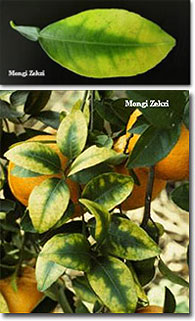
- Occurs on mature leaves with young leaves appearing normal
- Inverted green V-shape surrounded by yellowing
- Fruit yield and quality is reduced; seedy varieties are more Magnesium
- Deficiency severely affected by a magnesium deficiency than seedless varieties
Sulfur Deficiency
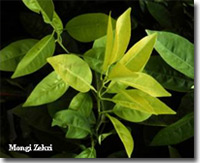
- Occurs on new growth
- Pale green to yellow in color
- Fruit peel is pale and smooth
Iron Deficiency

- Occurs on young leaves
- Green veins with the leaf appearing light yellowish to white in color
- Small fruit
Zinc Deficiency
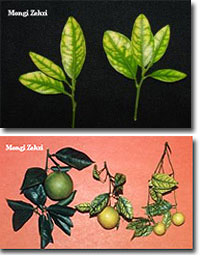
- Occurs first on new growth and remains on leaf as it matures
- Reduced leaf size, narrow leaves, yellow mottled on green background
- Decreased overall fruit yield
Manganese Deficiency

- Occurs on young leaves
- Dark green veins with a lighter green background
- Small, soft fruit
Boron Deficiency
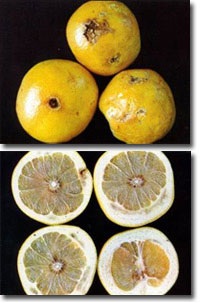
- Occurs on younger leaves first
- Leaves show small water-soaked spots
- Fruit becomes hard and dry
Copper Deficiency
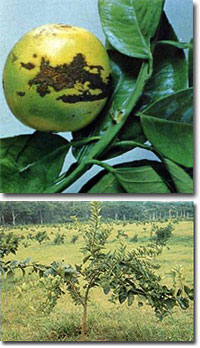
- Occurs on new growth first
- Leaves are uniform in color, long-willow looking leaves, bushy appearance, dieback
- Fruit splitting, gumming
Molybdenum Deficiency
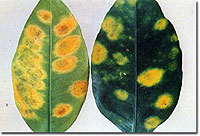
- Occurs on mature leaves first
- Interveinal chlorotic spots in early summer
- Under severe conditions, fruit has large irregular brown
spots surrounded with yellow discoloration
Nickel Deficiency
- No one has ever seen a nickel deficiency soil-grown plant
Chlorine Deficiency
- No one has ever seen a chlorine deficiency soil-grown plant
-
Management
- You should manage your grove as if you already have greening
- It is an integrated approach of the use of disease free nursery stock, reduction of the inoculum by frequent disease surveys, removal of symptomatic trees and suppression of the Asian citrus psyllid
Antibacterial Management
- Suggested Antibacterial Product Use Pattern for Huanglongbing (HLB; citrus greening) Management PDF
- Crisis Declaration PDF
Propagation
- Use of clean bud wood and certified healthy trees
- Only purchase trees from a certified nursery
Tree Removal
- Only way to ensure infected trees will not serve as a source inoculum
- Pruning of symptomic branches will NOT be successful
Scouting
Frequency
- Four times a year is recommended
- If you currently have greening in your grove or close by, scouting more than four times a year is recommended
- Symptoms are most easily seen September through March
- During the spring flush, scouting becomes more difficult and scouts should look further into the tree canopy
Methods
- Tractor or pickup mounted platform
- Use a mounted platform for taller trees - ATV's
- Medium sized trees can be scouted from an ATV - Walking
- Young trees can be scouted by walking - Tractor or pickup mounted platform

Diagram on a suggested scouting movement within a grove
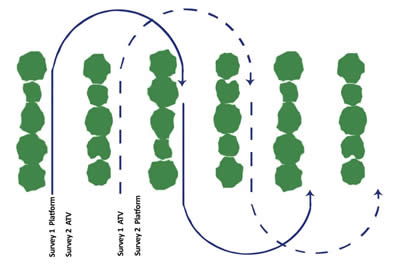
Grove Conditions
- Scouting is more difficult in an unkept grove
- Nutritional deficiencies can cause greening symptoms to blend and go unnoticed
- Excessive weeds and unmanaged row middles cause scouts to watch where they are walking more than scouting
- Tree size
Flagging
- Several colored flagging tapes are available
- Choose a tape that will only be used for greening and cannot be confused with other colored flagging tape
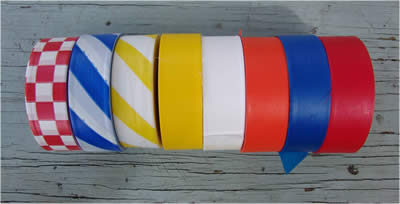
• If a suspect tree is found, flag the suspected branch and write on the flagging tape the inspector's name and date
• Mark the end of the row and the number of suspect trees in that row
Safety Concerns
- Grove conditions
- Chemical spray applications
- Weather
- Potential for slips and falls
Additional Resources
- Scouting for Citrus Greening (brochure)
- Scouting for Citrus Greening (Huanglongbing; HLB)
Asian Citrus Psyllid Management
-
Some biological control of the psyllid is available but the amount of psyllid control provided by introduced parasitoids has been insufficient to slow disease spread
-
Area wide spay programs through citrus health management areas (CHMA)
-
Speed sprayer, low volume and aerial are application methods available
Grower Experience
Host Plants
- If possible, remove host plants, Murraya paniculata (orange jasmine) and Severinia buxifolia (box orange) from around a commercial citrus grove
Photo Credit: Steve Futch, Ph.D.
-
Links
UF/IFAS Publications
Current
- Asian Citrus Psyllid, Diaphorina citri Kuwayama (Insecta: Homoptera: Psyllidae)
- An Asian Citrus Psyllid Parasitoid: Diaphorencyrtus aligarhensis (Shafee, Alam and Agarwal) (Insecta: Hymenoptera: Encyrtidae)
- An Asian Citrus Pysllid Parasitoid Tamarixia radiata (Waterston) (Insecta: Hymenoptera: Eulophidae)
- Florida Citrus Production Guide: Asian Citrus Psyllid and Citrus Leafminer PDF
- Florida Citrus Production Guide: Huanglongbing (Citrus Greening) PDF
- Frequently Asked Questions about Huanglongbing (HLB; citrus greening) for Homeowners
- Impact of Citrus Greening on Citrus Operations in Florida
- Irrigation Management of HLB-Affected Trees
- Managing the Health and Productivity of HLB-Affected Groves
- Scouting for Citrus Greening (Huanglongbing; HLB)
- Tree Assistance Program for Florida Citrus Greening
- What is the Economic Benefit of a Citrus Health Management Area (CHMA)? A Case Study
Archived
*All documents are in PDF format
- An Iodine-Based Starch Test to Assist in Selecting Leaves for HLB Testing PDF
- Biology and Management of the Asian Citrus Psyllid, Diaphorina citri Kuwayama, in Florida Citrus PDF
- Citrus Greening and Citrus Tree Planting in Florida PDF
- Dooryard Citrus Production: Citrus Greening Disease PDF
- Dooryard Citrus Production: The Value of the Florida Citrus Industry to Florida Residents PDF
- Economic Evaluation of Citrus Greening Management and Control Strategies PDF
- Economic Impacts of the Florida Citrus Industry in 2007-08 PDF
- Economic Impacts of Citrus Greening (HLB) in Florida, 2006/07–2010/11 PDF
- GPS Accuracy for Tree Scouting and Other Horticultural Uses PDF
- IFAS Guidance for Huanglongbing (Greening) Management PDF
- The Dynamics and Implications of Recent Increases in Citrus Production Costs PDF
- The Incidence of Greening and Canker Infection in Florida Citrus Groves from September 2007 through August 2008 PDF
UF/IFAS Identification Tools
- Huanglongbing (HLB; citrus greening) Leaf and Fruit Symptom Identification
- Huanglongbing (HLB; citrus greening) and Nutrient Deficiency Identification
- Citrus Greening (Huanglongbing; HLB) versus Citrus Tristeza and Blight
- Quick Reference Guide to Citrus Insecticides and Miticides
- Tap Sampling for Asian Citrus Psyllid (ACP) Field Sheet
- Muestreo por Golpeo para el Psílido Asiático de los Cítricos (PAC). Hoja de campo
- Citrus Pest Identification PDF
UF/IFAS Brochures
- Citrus Greening (Huanglongbing): A Serious Threat to the Florida Citrus Industry
- The Effects of Huanglongbing on Florida Oranges
- Scouting for Citrus Greening
- Understanding Low Volume Application Technology
- Citrus Canker and Greening (HLB) Handling Protocols for Master Gardener Plant Clinics
Citrus Greening Articles and Websites
- APHIS-Citrus Greening
- California Citrus Threat
- Citrus Health Response Program
- Featured Creatures - Asian Citrus Psyllid
- F.D.A.C.S. Division of Plant Industry
- HLB (Greening) Database
- Huanglongbing: A Destructive, Newly-Emerging, Century-Old Diesease of Citrus
- Invasive Species-Citrus Greening
- HLB Scion Survey
-
Regulations
Citrus Growers and Caretakers
• Must sign a compliance agreement and submit a business plan
• Required to decontaminate upon exiting a grove
• Decontamination upon entering a grove is optional
• Only fruit being shipped to the European Union Markets are required to have pre-harvest inspections
• Only purchase trees from a certified nursery
Citrus Harvesters
• Must sign a compliance agreement and submit a business plan
Citrus Processors
• Must sign a compliance agreement and submit a business plan
• The business plan must determine the company procedures for decontamination
Citrus Packers
• Must sign a compliance agreement with the USDA
Citrus Nursersies
• As of January 1, 2007 all citrus nursery propagations must occur in enclosed greenhouses
• As of January 1, 2007 all citrus nursery propagations must occur in enclosed greenhouses
• New nursery sites must be one mile from citrus groves. Existing sites can remain, but must build their nursery structure to comply with all other regulations
• All budwood must be grown in structures meeting the rule requirements, tested annually for pathogens, registered with the Florida Division of Plant Industry and originated from screened budwood sources
• Nurseries must be inspected every thirty days
• All new nursery sites and structures must be approved by Florida Division of Plant Industry
• As of January 11, 2008, all plants and plant parts, including but not limited to nursery stock, cuttings, budwood, and seed (excluding fruit), of Citrus spp., Murraya spp., etc may not be moved between states from areas quarantined due to citrus greening

• https://www.fdacs.gov/Divisions-Offices/Plant-Industry/Office-Locations/Plant-Inspector-Directory/Commercial-Citrus-Nursery-Inspector-Directory
For more information on Florida citrus regulations, please contact the Division of Plant Industry 863-298-3000 -
Pathogen
-
Candidatus Liberibacter spp. are phloem-limited plant pathogenic bacteria.The phloem system of the plant transports sugars, which are the food source of the plant, bidirectionally through the plant. The phloem system of the plants transports the products of photosynthesis (sugars) from sources of photosynthetic activity (leaves) in the plant to sinks (flowers, fruits, roots, seeds).
-
Psyllids are the main means of transmission to plants. An infected psyllid feeds on a healthy tree and injects the bacterium into the phloem. Once a tree is infected with the bacterium, there is no known cure for the disease. This in part is because the bacterium is inside the vascular system of the plant (systemic) and is therefore very difficult to access.
-
The bacterium is Gram-negative. Part of the evidence used to show that the bacterium is Gram-negative was the fact there were two membranes (figure 2), outer and cytoplasmic, and a thin peptidoglycan layer in between the cell walls seen in electron micrographs.
-
At this time, greening has not been cultured, but ongoing research shows promise this will be accomplished. Once the bacterium has been isolated in pure culture plant pathologists will be able to complete Koch's postulates (pathogenicity tests). Completetion of Koch's postulates will allow plant pathologists to definitively say Ca. Liberibacter sp. causes the symptoms of HLB.
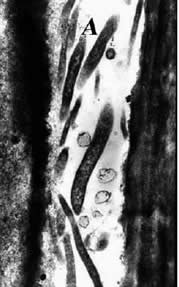
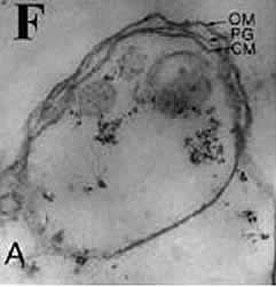
Figure 1. Electron micrograph of Ca. Liberibacter cells in a sieve tube of sweet orange leaf in Saudi Arabia Figure 2. The peptidoglycane layer of the Gram negative cell wall can be visualized (PG) in between the inner membrane cytoplasmic membrane (CM) and the outer cell wall membrance (OM).
Photo Credit: Huanglongbing: A Destructive, Newly-Emerging, Century-Old Disease of Citrus, J.M. BovéVarious Species of Ca. Liberibacter
FORMVECTORHEAT TOLERANCEAsianDiaphorina citri (psyllid)*heat tolerantAfricanTrioza erytreaae (psyllid)*heat-sensitiveAmericanDiaphorina citri ( psyllid)heat tolerant*It has been shown experimentally that the two psyllids can transmit both the Asian and African forms, but the preferential vector is shown above.
Various Names of HLB (Huanglongbing) throughout the World
HLB became the official name because it was the first recorded in the literature.
- South Africa: greening
- Philippines: mottle leaf
- India: dieback
- Indonesia: vein phloem degeneration
- China: Huanglongbing (yellow shoot or yellow branch disease)
- Taiwan: likubin
-
-
Symptoms
- Symptoms can be found year round, but are most easily seen from September through March
- The disease affects all parts of the tree canopy - leaves, twigs and fruit
-
As the disease progresses, it will cause the whole tree to decline
Leaf Symptoms
- Leaf symptoms include blotchy mottle, yellow veins, vein corking or green islands
- Yellow veins, vein corking or green islands are not diagnostic alone
- Blotchy mottle is the best diagnostic leaf symptom of greening
- Blotchy mottle: a random pattern of yellowing (chlorosis) on leaves that is not the same on the right and left sides of the leaf
- Yellow veins can be confused with other diseases (e.g. foot rot) or damage (e.g. broken or girdled limb)
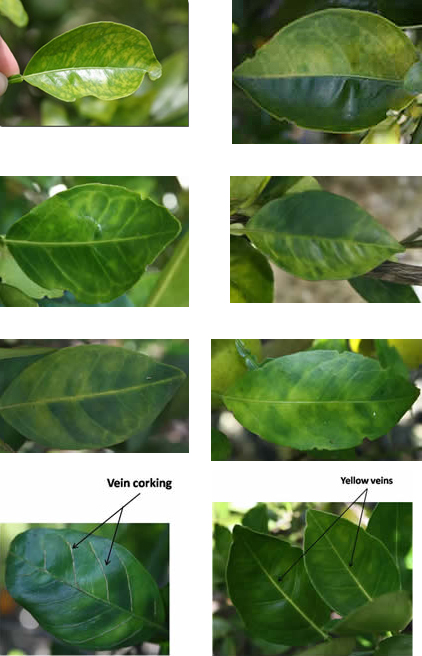
Pen Test for Leaves
- A simple procedure to determine if symptoms are the same on both halves of a leaf
- Draw two circles on opposite halves of the leaf
- Is the pattern the same in both circles?
- Different patterns indicate potential greening if other problems have been ruled out
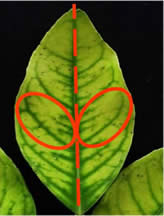
Nutrient Deficiency
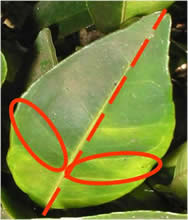
Greening
Fruit Symptoms
- Fruit external appearance may be lopsided, misshapen or small green fruit
- The fruit would taste salty and bitter
- The internal appearance may have aborted seeds, yellow stain beneath the calyx button and/or a curved central core
Tree Appearance
- Yellow shoots
- Twig dieback
- Stunting
- Off-season bloom
- Overall tree decline

-
Diagnostics
- PCR (Polymerase Chain Reaction) is the only way to positively identify citrus greening
Testing Sites
- Florida Division of Plant Industry
PO Box 147100, Gainesville, FL 32614-7100
(800) 282-5153 - UF Plant Diagnostic Center
Building 1291, 2570 Hull Rd. Gainesville, FL 32611
352-392-1795
http://plantpath.ifas.ufl.edu/extension/plant-diagnostic-center/
Field Test
- The iodine-based starch test is used to aid in the selection of leaves for PCR testing
- Greening infected trees and various other citrus diseases show an increased level of starch accumulation
- By using an iodine and water solution, it can be applied to a leaf to exhibit starch levels
- This does NOT verify a positive greening infected tree
- An Iodine-Based Starch Test to Assist in Selecting Leaves for HLB Testing
-
Photo Gallery
...
-
Contacts
Megan Dewdney, Ph.D.
Plant Pathologist Extension Specialist
863-956-8651
mmdewdney@ufl.eduLauren Diepenbrock, Ph.D.
Entomology
863-956-8801
ldiepenbrock@ufl.eduLukasz Stelinski, Ph.D.
Entomology and Nematology
863-956-1151
stelinski@ufl.eduJamie Burrow
Extension Program Manager
863-956-8648
jdyates@ufl.eduTripti Vashisth
Horticultural Sciences and Citrus Extension Specialist
863-956-4631
tvashisth@ufl.eduChris Oswalt
Multi-County Citrus Extension Agent
Polk and Hillsborough Counties
863-519-8677
wcoswalt@ifas.ufl.eduAjia Paolillo
Multi-County Citrus Extension Agent
DeSoto, Desoto, Hardee, Manatee
863-993-4846
ajiacunningham@ufl.eduMongi Zekri, Ph.D.
Multi-County Citrus Extension Agent
Hendry, Glades, Lee, Charlotte and Collier Counties
863-674-4092
maz@ifas.ufl.eduLourdes Pérez Cordero
Citrus Extension Agent
Highlands County
863-402-6540
lperezcordero@ufl.eduAmir Rezazadeh
Multi-County Citrus Extension Agent
St. Lucie, Indian River
772-462-1628
amir2558@ufl.eduMatt Smith
Citrus Extension Agent
Sumter - Central
352-569-6862
smith197@ufl.eduDanielle Sprague
Citrus Extension Agent
Jefferson
850-342-0187
dsprague@ufl.eduBrandon White
Multi-County Citrus Extension Agent
Orange, Lake
352-343-2729
brandon1.white@ufl.edu

